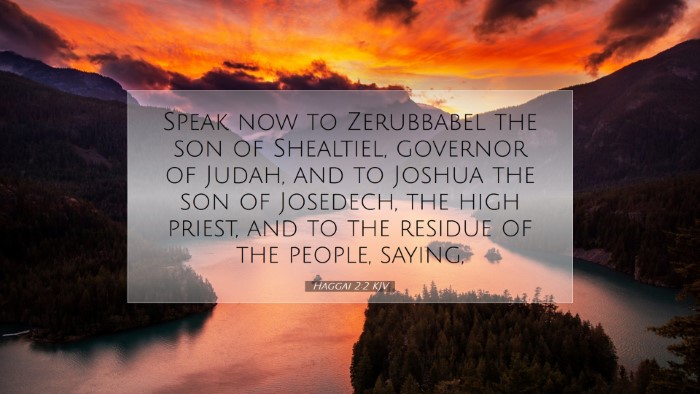Old Testament
Genesis Exodus Leviticus Numbers Deuteronomy Joshua Judges Ruth 1 Samuel 2 Samuel 1 Kings 2 Kings 1 Chronicles 2 Chronicles Ezra Nehemiah Esther Job Psalms Proverbs Ecclesiastes Song of Solomon Isaiah Jeremiah Lamentations Ezekiel Daniel Hosea Joel Amos Obadiah Jonah Micah Nahum Habakkuk Zephaniah Haggai Zechariah MalachiHaggai 2:2
Haggai 2:2 KJV
Speak now to Zerubbabel the son of Shealtiel, governor of Judah, and to Joshua the son of Josedech, the high priest, and to the residue of the people, saying,
Haggai 2:2 Bible Commentary
Commentary on Haggai 2:2
Introduction
Haggai 2:2 is a pivotal verse in the study of post-exilic Israel, marking a significant moment of renewal and encouragement for the people of God. This verse comes at a time when the Jewish exiles had returned to Jerusalem and were faced with the daunting task of rebuilding the temple after its destruction by the Babylonians. The context of Haggai's message serves to motivate the leaders and the people toward a renewed commitment to God’s work.
Text of Haggai 2:2 (ESV): "Speak now to Zerubbabel the son of Shealtiel, governor of Judah, and to Joshua the son of Jehozadak, the high priest, and to all the remnant of the people, and say,"
Historical Context
The historical backdrop of Haggai is crucial for understanding its message. After the Babylonian exile, the Jewish people were allowed to return to their homeland under the decree of Cyrus the Great. The initial fervor of rebuilding the temple faced significant challenges, including opposition, apathy, and discouragement. Haggai, as a prophet of the Lord, was called to confront these issues and revive the spirit of the people toward reconstruction and restoration.
Key Figures in the Verse
- Zerubbabel: As the governor of Judah, Zerubbabel represented the political leadership and was responsible for ensuring the proper governance of the returned exiles. His lineage traced back to David, adding a messianic significance to his role.
- Joshua: The high priest, Joshua, symbolized the spiritual leadership that was crucial for the restoration of worship and covenant fidelity among the people.
- The Remnant: The mention of 'all the remnant of the people' emphasizes that God’s message was intended for everyone, including those who may have felt insignificant in the face of monumental tasks.
The Divine Charge
Haggai’s prophetic calling to these leaders signifies the importance of unity between spiritual and political spheres in the restoration process. The verse serves as a divine command directed towards key figures, underscoring God's intention to involve them directly in the work ahead.
Theological Insights
1. God’s Sovereignty: The direct address from God through Haggai reaffirms His sovereignty and initiative in guiding His people. This serves as a reminder that God is actively involved in the affairs of His people and orchestrates events for His glory.
2. Restoration of Worship: The rebuilding of the temple is not merely about constructing a physical structure but restoring the heart of worship among God’s people. Worship is central to their identity as God's covenant community.
3. Encouragement for Leadership: The roles played by Zerubbabel and Joshua illustrate the importance of strong and faithful leadership in restoring faith and community. Their encouragement was crucial for motivating the people in their labor.
Challenges and Responses
The context of Haggai 2:2 reveals significant obstacles faced by the remnant. There was a sense of fear and apprehension among the people, borne of their past experiences and the visible setbacks in the rebuilding process. Haggai’s mandate not only serves to address these fears but also to call for an acknowledgment of God’s presence and power in their endeavors.
Public Domain Commentary Insights
Matthew Henry: In his commentary, Henry highlights that the emphasis on addressing both civil and religious leaders suggests that divine purposes involve the whole community. He notes that God’s willingness to communicate directly with the leaders indicates His commitment to the restoration project as part of His covenant promise.
Albert Barnes: Barnes reflects on the specific language and audience of the verse, emphasizing that God's encouragement was timely and necessary. He points out that the direct communication to the leaders underscores the importance of their roles in the reformation of the temple and the spiritual life of the people.
Adam Clarke: Clarke elaborates on the societal implications of the text, noting that the remnant needed to be spiritually revitalized. This revitalization was crucial for the collective identity as a nation chosen by God. Clarke stresses the importance of the temple’s rebuilding as a symbol of God’s covenant relationship with His people.
Applications for Today
The message of Haggai 2:2 is profoundly relevant for contemporary faith communities. It serves as a call to recognize the authority and guidance of God in leadership roles and emphasizes the significance of collective involvement in spiritual endeavors. Here are several applications drawn from the text:
- Leadership and Responsibility: Just as Zerubbabel and Joshua were called to lead, today’s leaders must recognize their role in guiding their communities towards spiritual restoration and growth.
- Community Engagement: The call to "all the remnant" reflects the inclusivity needed within the church today, encouraging everyone to participate in the work of ministry regardless of their status.
- Faith Over Fear: The presence of fear among the people is relatable, and this scripture urges us to put our trust in God’s promises even when challenges seem insurmountable.
- Restoration of Worship: The rebuilding of the temple can be analogized to the need for rebuilding personal and corporate worship practices that honor God in today’s church settings.
Conclusion
Haggai 2:2 serves as a powerful testament to the faithfulness of God in calling His people to restore their devotion and commitment to Him. Through the prophetic voice of Haggai, leaders are urged to rise to the occasion, fostering an environment where worship and communal identity can flourish once more. For pastors, students, theologians, and Bible scholars, this text is a call to reflect on the roles they play in God’s ongoing story of redemption and restoration.


